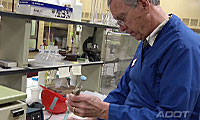Science of Transportation: Chloride and Sulfate testing
Science of Transportation: Chloride and Sulfate testing

Today, we’re going back into the lab to learn about two important soil tests regularly performed by ADOT…
One test determines the soil’s sulfate content and the other determines its chloride content – both are typically performed on backfill, which is material that will be used to fill an excavated space that ADOT is preparing for a project.
The reason ADOT tests soil for the two water-soluble ions is because, in certain amounts, sulfate and chloride can affect structures.
“Chloride, like other salt and acid anions, promotes corrosion of the steel,” said Transportation Materials Chemical Analyst Jeffrey Faulkner, adding that, over time, sulfate can attack concrete.
There are various ways to mitigate any impacts, depending on the amounts are found.
In the video above, you can see an abbreviated look at how both tests are performed, but there actually are several steps involved.
However, we do want to point out a couple of interesting things about the tests…
Ever hear of a turbidimeter? You’ll notice that the sulfate test utilizes one. It’s an instrument that uses light to measure the turbidity or “cloudiness” of a solution.
“Turbidity is directly related to the sulfate concentration,” says Faulkner. “The more sulfate that was in the soil, the cloudier the derived solution and the turbidimeter then measures that.”
We were also amazed to learn that electrodes are used in the chloride test. Not just any electrodes, though. These are electrodes designed to respond to chloride in solution and they’re inserted into the test mixture as it is stirred at a constant rate.
As we already stated, several steps are involved for both tests. Throughout many of those steps, values are recorded, which are plugged into equations that calculate the soil’s sulfate and chloride content in parts per million.
According to Faulkner, the ADOT lab performs these tests on about 200 soil samples each year. The information gained from the tests is used by engineers to help maximize the performance and longevity of the highway components that are being built.
You might think that highway construction is all about big machinery, heavy-duty vehicles, massive structures and materials by the ton – but it’s not. Sure, those are important, but when it comes to building a road, science plays a strong role too. In fact, the work ADOT does off the project site and inside a lab is so significant that we are highlighting it here on the blog with a new series we’re calling, The Science of Transportation.
